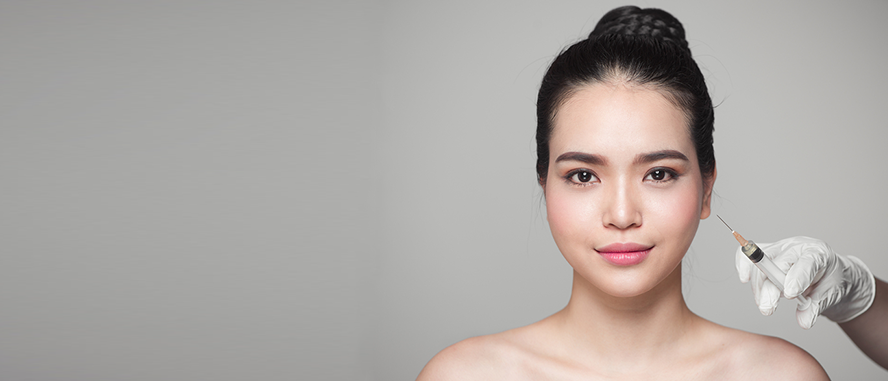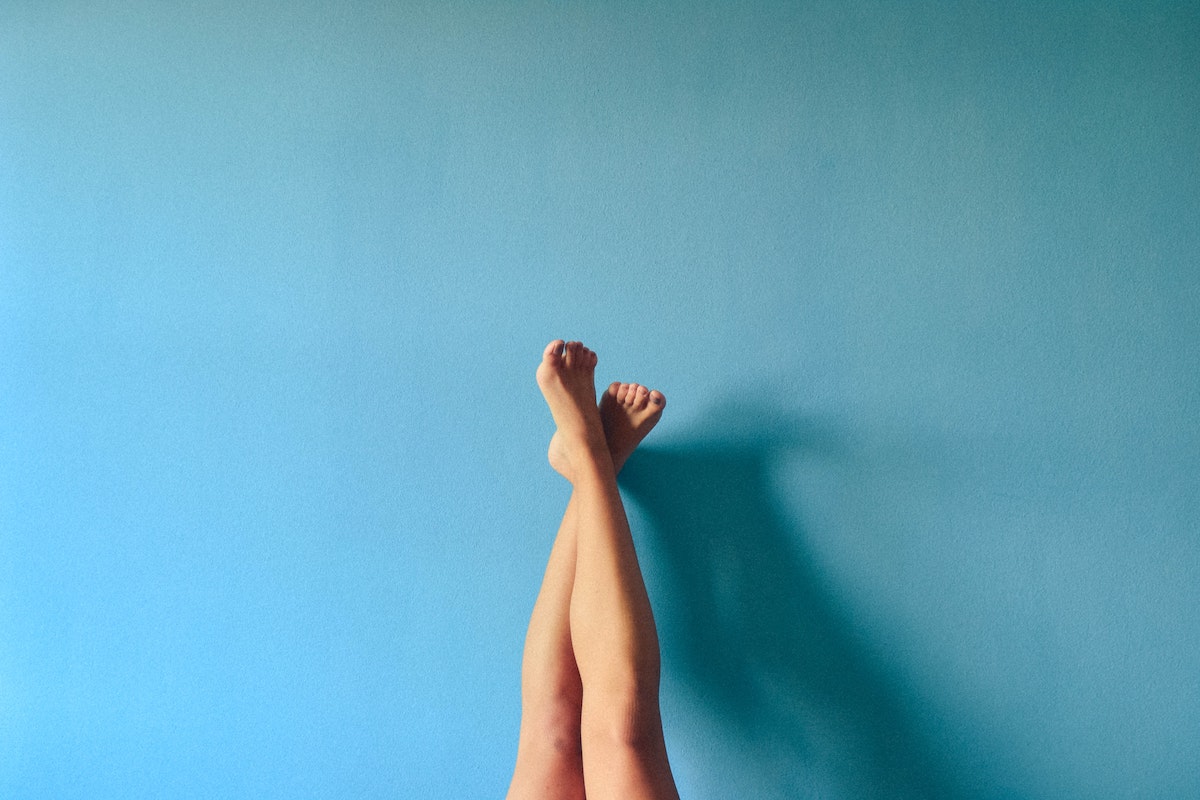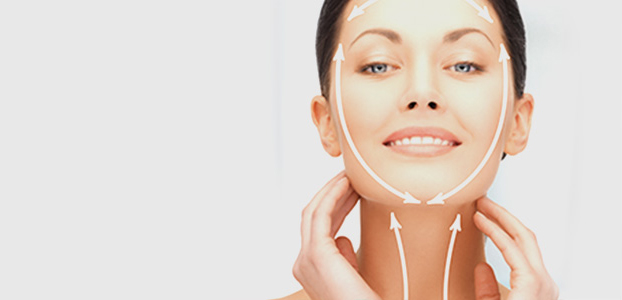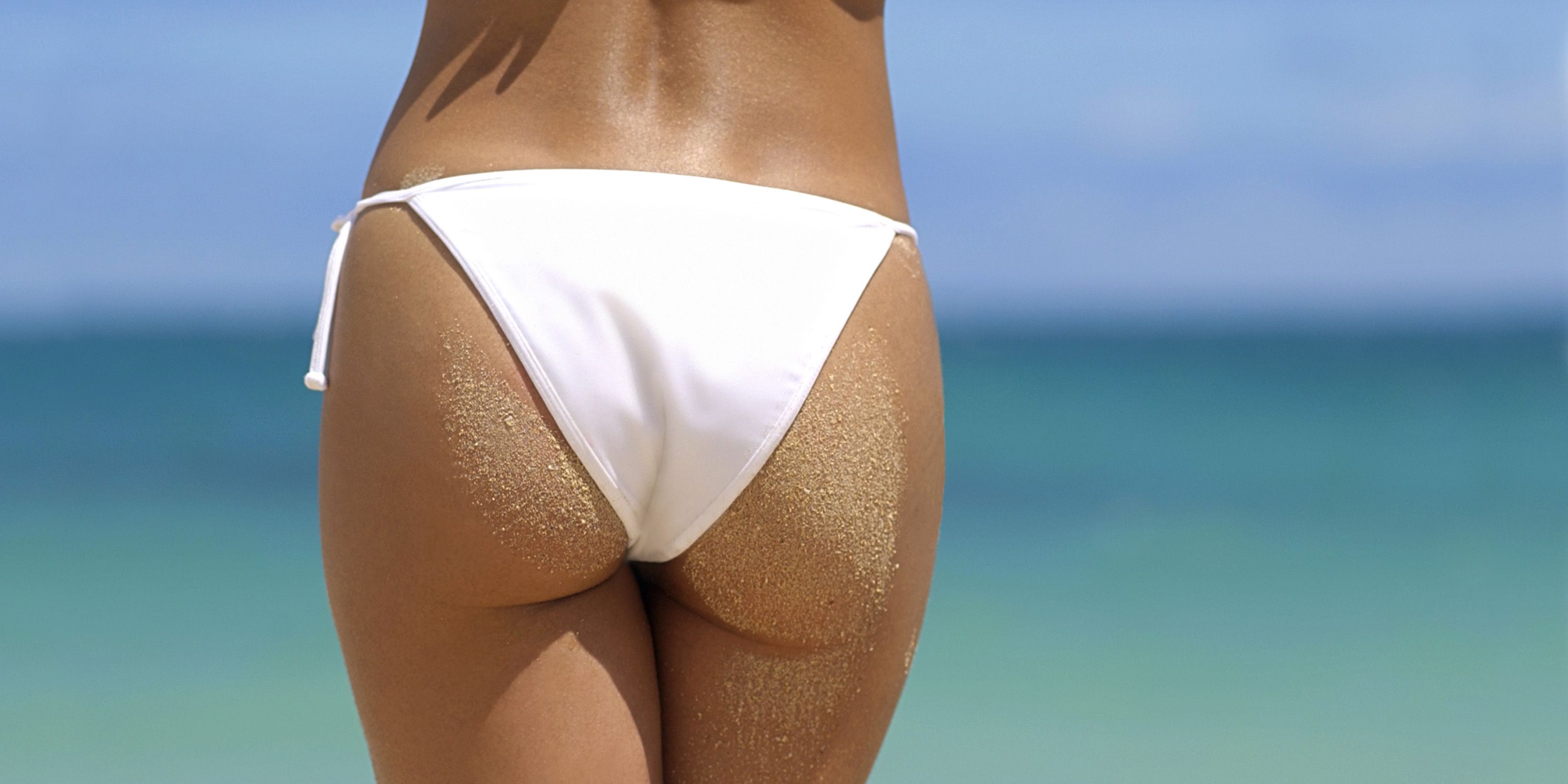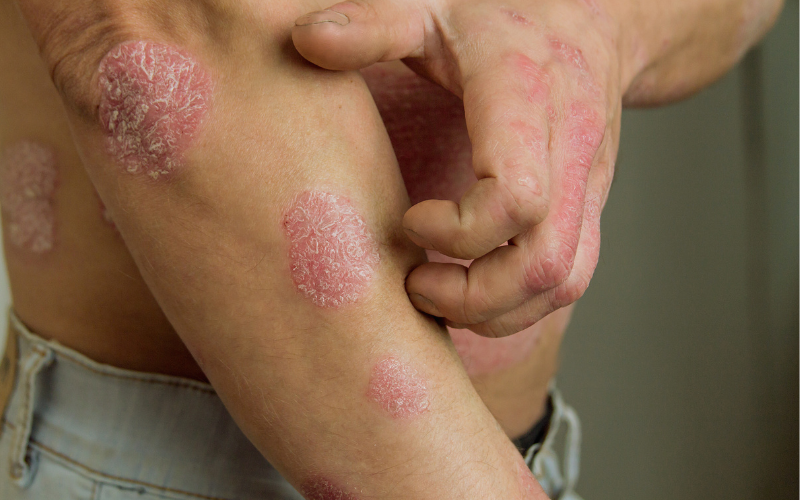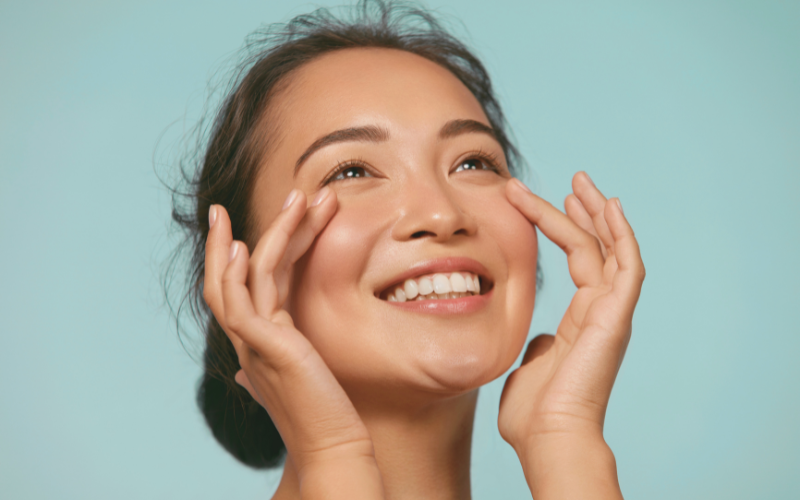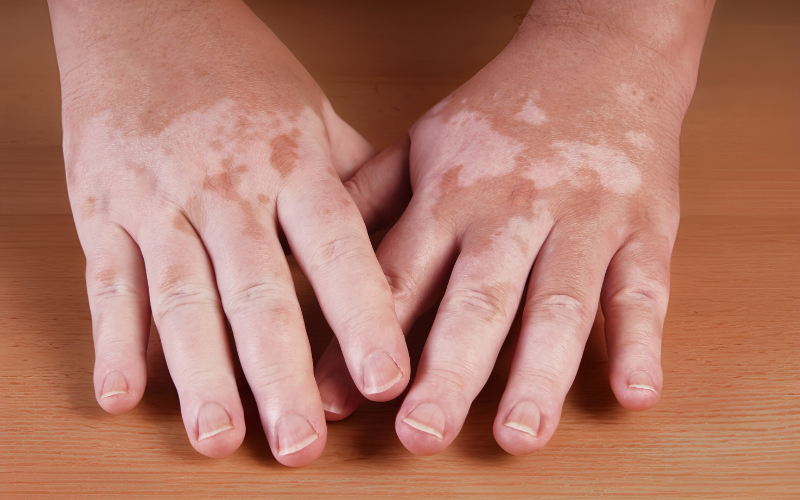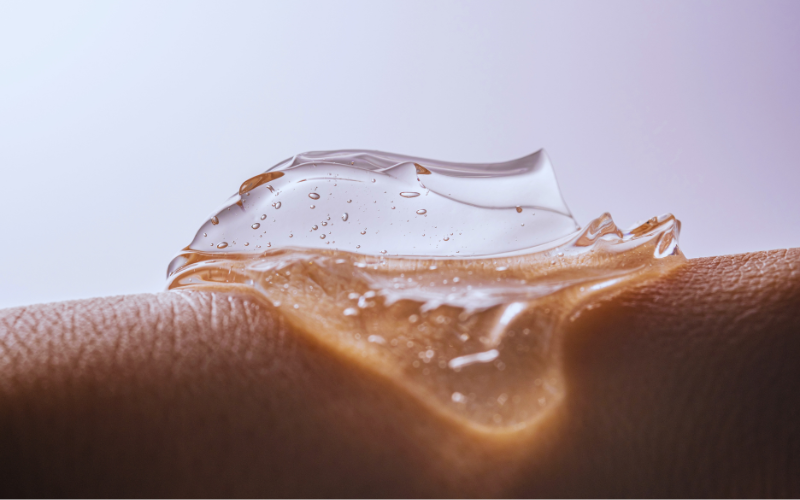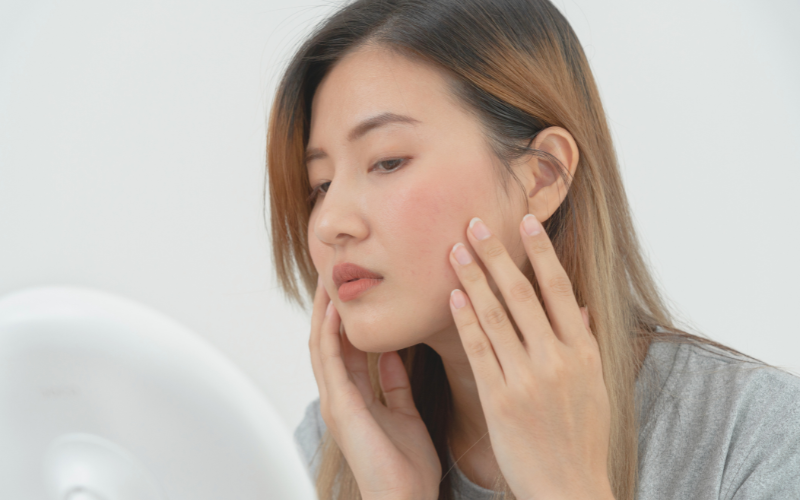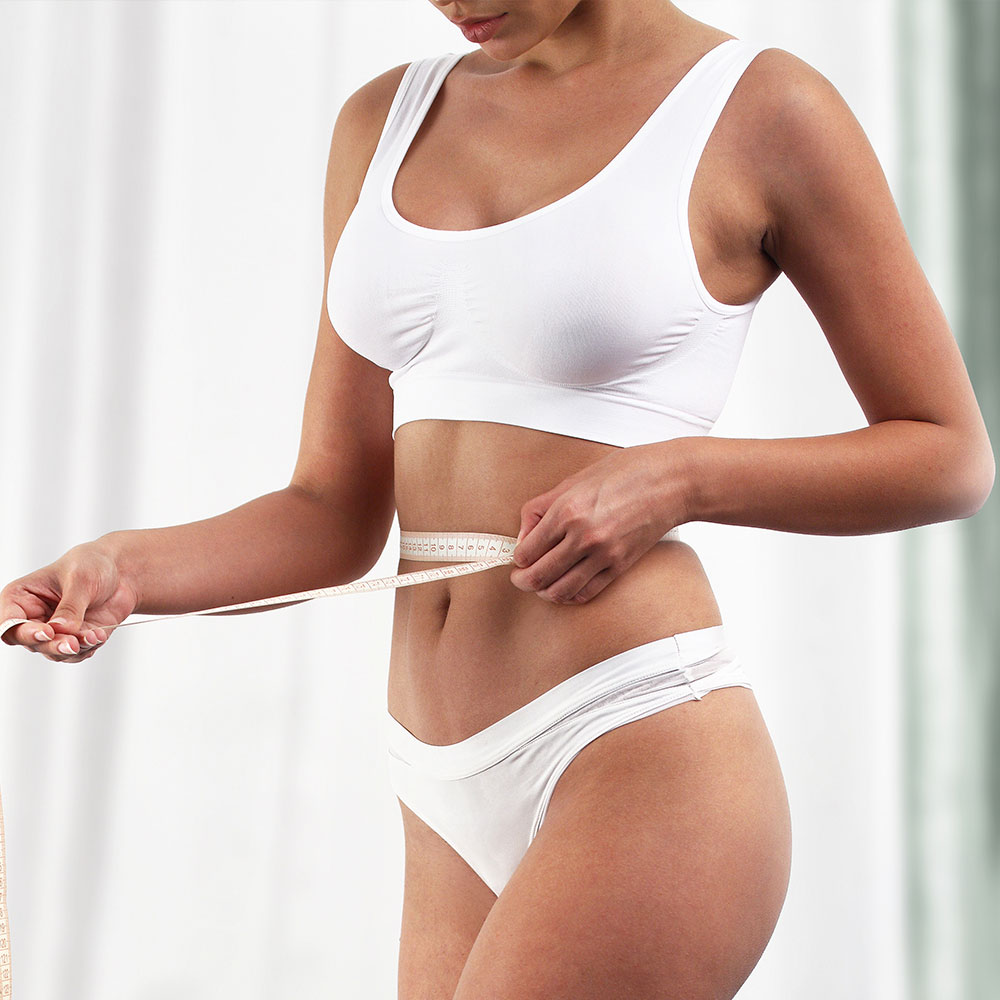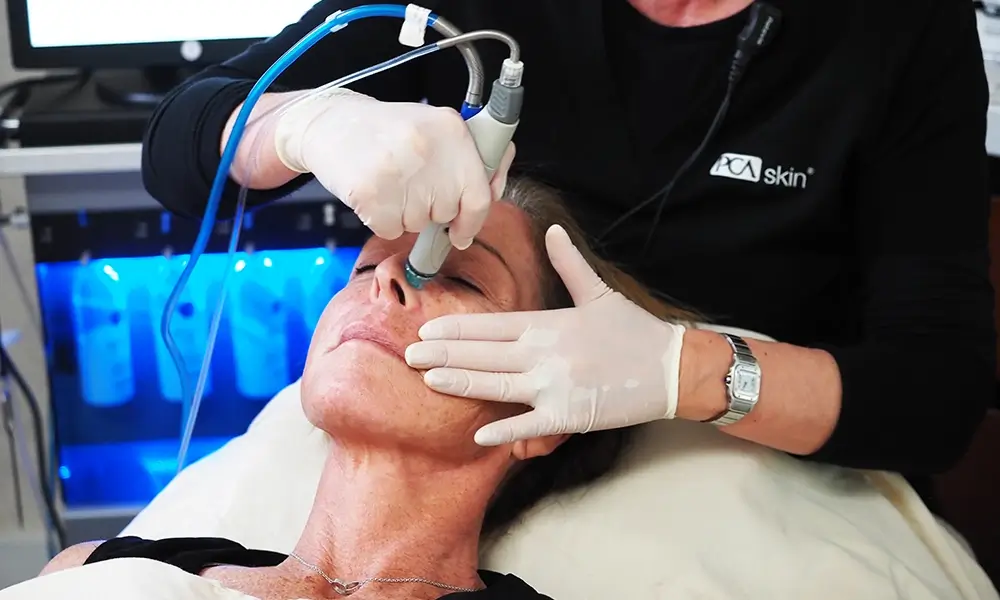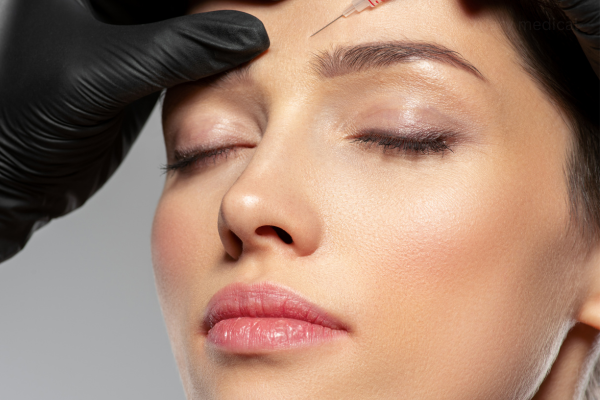Psoriasis affects millions of Americans, causing red, scaly patches that can be both physically uncomfortable and emotionally challenging. This chronic skin condition occurs when skin cells multiply too quickly, resulting in characteristic patches that often appear on the elbows, knees, scalp and torso. The rapid cell turnover can cause inflammation and plaques that may crack, bleed and become painful during flare-ups.
At Sanctuary Medical Aesthetic Center in Boca Raton and Fort Lauderdale, we offer comprehensive treatment options for psoriasis patients seeking relief and clearer skin. Our board-certified dermatologists specialize in managing this complex condition through various medical and therapeutic approaches tailored to each patient’s needs.
Understanding Psoriasis: Types and Symptoms
Before discussing treatments, it’s important to understand what’s happening with your skin. Psoriasis is not just a cosmetic issue – it’s an immune-mediated condition where your skin cells multiply much faster than normal, leading to distinct symptoms. If you’ve recently been diagnosed, you might be experiencing one of these common types:
Plaque Psoriasis
The most common type, characterized by raised, red patches covered with silvery-white scales. These plaques may itch, burn, or crack and bleed.
Guttate Psoriasis
Appears as small, dot-like lesions, often following a streptococcal throat infection.
Inverse Psoriasis
Shows up as smooth, red patches in body folds such as the armpits, groin or under the breasts.
Pustular Psoriasis
Characterized by white pustules surrounded by red skin, most commonly on the hands and feet.
Erythrodermic Psoriasis
A severe, inflammatory form that affects most of the body surface, causing intense redness and shedding of skin layers.
Medical Treatments for Psoriasis
Modern dermatology offers numerous effective treatments to manage psoriasis symptoms and reduce flare-ups:
Topical Treatments
For mild to moderate psoriasis, prescription-strength creams and ointments are often the first line of defense:
- Corticosteroids: Reduce inflammation and relieve itching. Available in various strengths, these can be particularly effective for short-term use during flare-ups.
- Vitamin D analogues: Slow skin cell growth and reduce scaling. These are often prescribed alongside corticosteroids for better results.
- Retinoids: Help normalize skin cell production by regulating cell turnover. These vitamin A derivatives can cause sensitivity to sunlight.
- Calcineurin inhibitors: Reduce inflammation and plaque buildup, especially useful for sensitive areas like the face and skin folds.
- Coal tar: Reduces scaling, itching and inflammation. This traditional treatment has been used for decades with good results.
Light Therapy (Phototherapy)
This treatment uses natural or artificial ultraviolet light to slow skin cell turnover and reduce inflammation:
- UVB therapy: Controlled exposure to UVB light, which can be delivered as broadband UVB or narrowband UVB (which focuses on a smaller portion of the UVB spectrum for more precise treatment).
- PUVA: Combines UVA light with psoralen, a light-sensitizing medication. This treatment may be more effective than UVB for certain patients but carries additional considerations.
- Excimer laser: Targets specific areas with high-intensity UVB light, allowing for concentrated treatment of stubborn plaques while sparing healthy skin.
Systemics and Biologics
When topical treatments and light therapy aren’t providing enough relief for your psoriasis, your dermatologist may recommend stronger medications that work throughout your entire body. These treatments are typically reserved for moderate to severe cases or when psoriasis affects large areas of your skin.
- Methotrexate: Suppresses the immune system and slows skin cell production
- Cyclosporine: Suppresses the immune system
- Oral retinoids: Help reduce skin cell production
Biologic drugs are newer, advanced medications that target specific parts of the immune system:
- TNF-alpha inhibitors: Block an inflammatory protein
- Interleukin inhibitors: Target specific immune system pathways
- T-cell inhibitors: Affect T-cell function
Lifestyle Modifications and Home Care

While medical treatments are essential, certain lifestyle changes can help manage psoriasis:
Moisturize Regularly
Keep skin hydrated to reduce scaling and itching. Apply fragrance-free moisturizers after bathing.
Take Daily Baths
Short, lukewarm baths with colloidal oatmeal, Epsom salts or Dead Sea salts can help remove scales and reduce itching.
Get Some Sun
Limited, controlled sun exposure can improve symptoms. Always protect healthy skin with sunscreen.
Identify and Manage Triggers
Common psoriasis triggers include:
- Stress
- Infections
- Skin injuries
- Certain medications
- Cold, dry weather
- Alcohol consumption
- Smoking
Anti-Inflammatory Diet
Many of our patients find some relief by following an anti-inflammatory diet rich in specific foods that may help reduce systemic inflammation:
- Fatty fish rich in omega-3s: Try incorporating salmon, mackerel and sardines that contain natural compounds to fight inflammation
- Colorful fruits and vegetables: Load your plate with berries, leafy greens and orange produce for antioxidants
- Heart-healthy nuts and seeds: Walnuts, flaxseeds and chia seeds offer fats that support skin repair
- Extra virgin olive oil: Contains compounds with properties similar to anti-inflammatory medications
- Fiber-rich whole grains: Help reduce inflammatory markers throughout your body
You might notice improvements in your skin within several weeks of dietary changes, especially when combined with your medical treatment plan. Most patients see the best results when they reduce processed foods, excessive dairy, red meat and alcohol while increasing these beneficial foods.
Advanced Treatments at Sanctuary Medical Aesthetic Center
As the largest laser facility in South Florida, Sanctuary Medical Aesthetic Center offers cutting-edge treatments for psoriasis, including:
- Targeted Phototherapy: Our advanced laser systems deliver precise light therapy to affected areas, minimizing exposure to healthy skin and providing faster results with fewer treatments.
- Comprehensive Biologics Program: Access to the latest biologic medications administered by experts who monitor your progress and adjust treatments as needed.
- Integrative Approach: Combining medical treatments with professional skincare recommendations and lifestyle guidance to address all factors affecting your condition.
- Personalized Treatment Plans: Tailored to your specific type of psoriasis, severity, affected areas and lifestyle factors that may trigger flares.
Our team of board-certified dermatologists and medical professionals provides individualized care to address all aspects of psoriasis management, from immediate symptom control to long-term skin health maintenance. We work with you to find the right combination of treatments that fits your life and provides lasting relief.
When to Seek Professional Help
If you’re struggling with psoriasis, don’t wait until it becomes unbearable to seek expert care. You should consider scheduling an appointment with a dermatologist if:
- Your psoriasis is severe or covers large areas of your body
- Your home treatments aren’t providing adequate relief
- Your psoriasis causes you significant discomfort or pain
- The condition is affecting your daily activities or emotional well-being
- You’ve developed joint pain, which might indicate psoriatic arthritis
Take Control of Your Psoriasis Today
Don’t let psoriasis control your life any longer. At Sanctuary Medical Aesthetic Center, we combine medical expertise with the latest technologies to provide effective psoriasis treatment. Our team, led by world-renowned plastic surgeon Dr. Jason Pozner, collaborates with our board-certified dermatologists to develop a customized treatment plan that addresses your specific needs.
We understand the physical and emotional impact of psoriasis and are committed to helping you achieve clearer, more comfortable skin. Most patients begin seeing improvements within 4-8 weeks of starting treatment, with many experiencing significant clearing in 3-6 months with the right combination of therapies.
Contact Sanctuary Medical Aesthetic Center in Boca Raton or Fort Lauderdale today at (561) 247-2958 or book online to schedule your comprehensive psoriasis evaluation. Your journey to healthier skin can begin this week.
Frequently Asked Questions
Is psoriasis contagious?
No, psoriasis is not contagious. You cannot catch it from someone who has it, nor can you spread it to others through contact.
Can psoriasis be cured?
While there is currently no cure for psoriasis, various treatments can effectively manage symptoms and even lead to long periods of remission.
How is psoriasis diagnosed?
Dermatologists typically diagnose psoriasis through visual examination of the skin, scalp, and nails. In some cases, a small skin sample (biopsy) may be taken to confirm the diagnosis.
Will psoriasis go away on its own?
Psoriasis is a chronic condition that typically persists throughout life, with periods of flare-ups and remission. Proper treatment can lead to significant improvement and even temporary clearance.
Can children get psoriasis?
Yes, psoriasis can affect people of all ages, including children. In fact, about one-third of psoriasis cases begin in childhood.
How often should I see a dermatologist for my psoriasis?
The frequency depends on the severity of your condition and your treatment plan. Patients with moderate to severe psoriasis may need to see their dermatologist every few months to monitor their condition and adjust treatments as needed.
Can stress make psoriasis worse?
Yes, stress is a common trigger for psoriasis flares. Learning stress management techniques can be an important part of managing the condition.
























